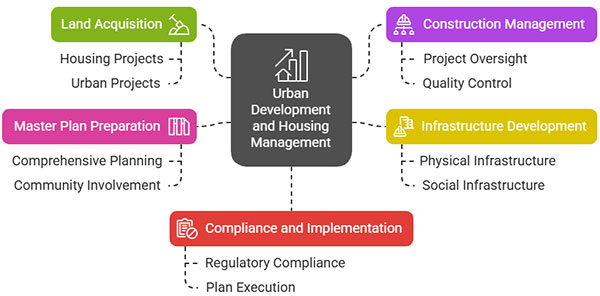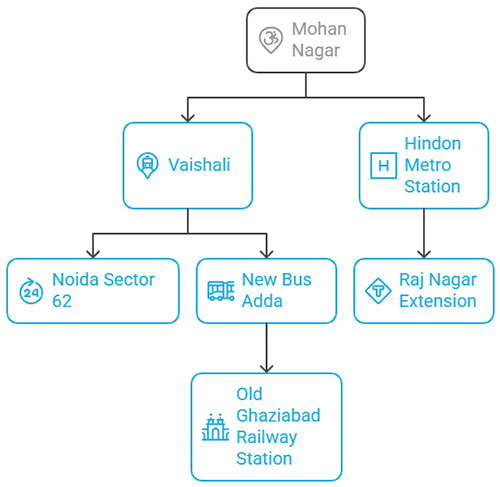Inside Ghaziabad's 2031 Vision: The Master Plan Reshaping Delhi NCR
- 4th Apr 2025
- 1186
- 0

Never miss any update
Join our WhatsApp Channel
The Ghaziabad Master Plan 2031 is setting new standards for urban development in one of India's fastest-growing cities. This comprehensive guide walks you through everything you need to know about this transformative plan that will reshape Ghaziabad's landscape and improve quality of life for its residents.
Latest Updates on Ghaziabad Development Projects
GDA Launches Online Platform for 1,630 Vacant Flats
In October 2023, the Ghaziabad Development Authority (GDA) introduced a convenient online facility for purchasing unsold properties under their First Come First Serve housing scheme. This initiative features properties ranging from affordable EWS units at Rs 5.70 lakh to premium 3 BHK apartments at Rs 69.40 lakh.
Currently, approximately 1,630 flats across eight housing schemes remain vacant. The new online platform allows interested buyers to apply directly through the GDA website without visiting their offices, making the process seamless and accessible.
Understanding Master Plans: The Blueprint of Urban Growth
A Master Plan serves as a strategic roadmap that outlines a city's future development trajectory. It's essentially a comprehensive strategy that details how a city's physical infrastructure and resources will evolve over an extended period.
With Ghaziabad rapidly emerging as a real estate hotspot in the Delhi NCR region, the Ghaziabad Master Plan 2031 has captured widespread attention from investors, homebuyers, and urban planners alike.
This upcoming plan will introduce significant changes to land use patterns to address the growing housing demands. Based on Geographic Information System (GIS) technology, it will replace the existing Ghaziabad Development Authority Master Plan 2021, bringing more precision and efficiency to urban planning.
The Ghaziabad Development Authority: Architects of Change
The GDA, established under the Urban Planning and Development Act 1973, is the primary authority responsible for creating and implementing the Ghaziabad Master Plan 2031. Their responsibilities include:
- Acquiring land for housing and urban development projects
- Managing construction for housing and development initiatives
- Developing physical and social infrastructure
- Preparing comprehensive master plans for the city's urban development
- Ensuring proper implementation and compliance with the master plan

Key Features of the Ghaziabad Master Plan 2031
In April 2022, the GDA approved the Master Plan 2031 for Loni and Muradnagar/Modinagar areas. The board meeting, chaired by Divisional Commissioner Surendra Singh, also approved a Public Private Partnership (PPP) model for innovative ropeway projects in the city.
Land Development Initiatives
The GIS-based Master Plan proposes approximately 95 hectares of additional housing development across three key areas, including about 50 hectares in Ghaziabad proper. The city encompasses 522 square kilometers of geographical area, carefully divided according to specific land uses including residential, commercial, and industrial zones.
Special Development Areas (SDAs)
Beyond traditional zoning, the Master Plan introduces:
- Two Special Development Areas (SDAs)
- Seven influence zones along the Regional Rapid Transit System (RRTS) corridor
According to Commissioner Singh, dedicated SDA authorities will implement special development plans at Duhai and Guldhar along the Delhi-Meerut Road. These will cover areas of 250 and 400 hectares respectively, connected by the RRTS network.
Township Development
The GDA has proposed innovative township hubs within the SDAs to facilitate planned residential, commercial, and industrial development. These townships will be strategically located near the RRTS project stations to maximize connectivity.
A major township development with residential, commercial, industrial, and logistics facilities is planned near the Ghaziabad-Meerut border at Bhojpur. This prime location offers excellent connectivity:
- Just 25 minutes from Delhi via the Delhi-Meerut Expressway
- Close proximity to the Eastern Peripheral Expressway
- Easy access to the upcoming Ganga Expressway
Revolutionary Ropeway Project
The GDA is conducting detailed feasibility studies for several ropeway routes, including:
- Mohan Nagar to Vaishali (with potential Metro connectivity)
- Vaishali to Noida Sector 62
- Hindon Metro station to Raj Nagar Extension
- New Bus Adda to Old Ghaziabad Railway Station

The National Highways Authority of India (NHAI) is leading feasibility studies for these routes, with estimated costs of Rs 85-90 crore per kilometer. These ropeways will serve as alternative transportation options to complement existing Metro rail routes in Ghaziabad.
Public Participation in the Planning Process
In August 2022, the GDA initiated a 20-day public objection hearing phase for the Master Plan. This democratic process allowed citizens to voice concerns and suggest improvements.
The authority received approximately 1,260 objections, with 1,100 unique submissions after removing duplicates. Around 850 objections pertained to city areas, while others came from Modinagar/Muradnagar and Loni regions.
Most objections centered on:
- Land use conversion requests
- Transformation of green areas to commercial or residential zones
- Non-conforming land use issues
According to standard planning norms, about 45% of land under a master plan is designated for residential use, while 15% is preserved for green areas. Industrial and commercial land usage typically accounts for 5% and 2% respectively.
RRTS Integration and Zonal Planning
The GDA is finalizing a specialized zonal plan for areas along the RRTS corridor, aligning with the Uttar Pradesh government's Transit-Oriented Development (TOD) policy.
The 82-kilometer RRTS project will connect three major cities—Delhi, Ghaziabad, and Meerut—through a high-speed train network featuring 25 stations, with 22 located in Uttar Pradesh.
GDA Town Planner Rajiv Ratan Sah confirmed that seven RRTS stations and two SDAs will be incorporated into the zonal plan, becoming integral components of the Master Plan 2031. This plan will define physical boundaries of influence zones around RRTS stations and specify land usage for the two SDAs.
Transit-Oriented Development: The Future of Urban Planning
Transit-Oriented Development represents a forward-thinking approach to urban planning, creating sustainable communities centered around high-quality public transportation systems.
The Uttar Pradesh government has established three types of TOD zones:
- "Corridor TOD Zone": Areas within a 500-meter radius of mass transit alignment
- Station-centered zones within a 1.5-kilometer radius
- "High Potential Zones": Special areas near high-speed train corridors, highways, and expressways
The GDA has designated zones under the third TOD category along the RRTS corridor in Guldhar and Duhai in the final draft of the Master Plan 2031.
The RRTS project is progressing rapidly to meet its March 2025 deadline. A 17-kilometer stretch in Ghaziabad—designated as a "priority section"—is scheduled for commissioning in March 2023, making it the first operational RRTS segment in India.
Once approved by the state government, housing and commercial development outlined in the Master Plan will follow the zonal guidelines. This integrated approach will help recover the substantial costs of the RRTS project while generating revenue for the GDA.
The TOD Policy introduced by the Uttar Pradesh government promises numerous benefits:
- Improved convenience for commuters
- Enhanced quality of life for residents
- Expanded opportunities for businesses
- Strengthened local economy
- Creation of diverse employment opportunities
How to Contact the Ghaziabad Development Authority
For more information about the Ghaziabad Master Plan 2031 or to address any concerns, you can contact the GDA through the following channels:
| Address: | Vikas Path, near Old Bus Stand, Ghaziabad, Uttar Pradesh – 201001 |
| Email: | [email protected] |
| Office Hours: | 10 AM to 5 PM |
| Phone: | 0120-6110433 |
| WhatsApp: | +91-9990988004 |
Conclusion: The Road Ahead for Ghaziabad
The Ghaziabad Master Plan 2031 represents a pivotal moment in the city's development journey. While the final plan awaits state government approval, its impact on Ghaziabad's future cannot be overstated.
This comprehensive plan, with its innovative features like Special Development Areas, Transit-Oriented Development zones, township projects, and ropeway systems, promises to transform Ghaziabad into a model of sustainable urban development.
For investors, homebuyers, and residents, staying informed about the Master Plan's progress is essential for making strategic decisions. Whether you're considering purchasing property in one of GDA's housing schemes or planning long-term investments in the region, the Master Plan 2031 will significantly influence Ghaziabad's real estate landscape and overall livability.
As we await the final approval announcement expected by year-end, Ghaziabad stands on the threshold of an exciting new chapter in its development story—one that balances growth with sustainability, connectivity with community, and progress with quality of life.
Frequently Asked Questions
1. What is the Ghaziabad Master Plan 2031?
It's a comprehensive urban development strategy outlining Ghaziabad's physical and infrastructural growth until 2031, replacing the current Master Plan 2021.
2. When will the Ghaziabad Master Plan 2031 be fully implemented?
The plan is awaiting final approval from the Uttar Pradesh state government, expected by the end of 2023, with implementation phases continuing through 2031.
3. How can I purchase one of the vacant GDA flats?
You can apply directly through the GDA's official website using their online booking facility without visiting their office.
4. What are Special Development Areas (SDAs) in the Master Plan?
SDAs are designated zones at Duhai and Guldhar for integrated township development with planned residential, commercial, and industrial spaces.
5. How will the RRTS project benefit Ghaziabad residents?
The RRTS will provide high-speed connectivity between Delhi, Ghaziabad, and Meerut, reducing travel time and creating economic opportunities around transit hubs.
6. What percentage of land is allocated for residential use in the Master Plan?
Approximately 45% of the total land is designated for residential use, while 15% is preserved for green areas.
7. How can I raise objections or suggestions regarding the Master Plan?
You can contact the GDA directly via email at [email protected] or visit their office during the designated public feedback periods.
8. What is Transit-Oriented Development (TOD) and how will it change Ghaziabad?
TOD is an urban planning approach creating sustainable communities around transit systems, enhancing connectivity, increasing property values, and improving quality of life.

 Admin
Admin

Comments
No comments yet.
Add Your Comment
Thank you, for commenting !!
Your comment is under moderation...
Keep reading blogs